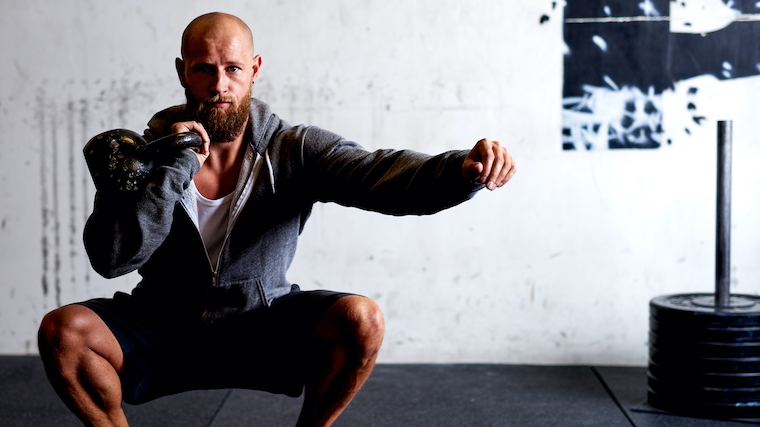Kettlebells are arguably the most versatile tool in the gym. They are used for swings, snatches, presses, deadlifts, squats, carries, rows, and even for the dreaded C word: cardio.
Although some lifters like to avoid cardio at all costs or head to the drudgery of the treadmill to perform their cardio mindlessly, the kettlebell can improve cardiovascular fitness in a relatively short amount of time. The kettlebell and your body are the only tools you need to sweat up a storm, and the variations a kettlebell allows for can stave off the monotony of the treadmill, elliptical, or stationary bike.

We are going to breakdown why kettlebells are excellent for specifically cardio purposes. Then, we’ll dive into some programming that you can try out and adapt to fit your needs.
Why Kettlebells Are Great For Cardio
The kettlebell design, with its thick handle and its offset center of mass (about six to eight inches from the handle), gives you great core, grip, and cardiovascular benefits. Why? Because the constantly shifting center of mass of the kettlebell with each repetition compels the stability and stabilizing muscles of your entire body to remain balanced. Additionally, the versatility of the swing, snatch, and squat the kettlebell with little to no transition time between moves can also improve your cardiovascular fitness and grip strength. No cardio machine can offer that.
Weight-bearing types of cardio like running, cycling and elliptical puts a stress on your joints. This is due to the impact you’re putting on them — gravity is not your friend here. This may beating on the joins can affect your recovery between lifting sessions. On the flip side, with the kettlebell, you can get a high intensity training session in without the jarring impact on your joints.
Furthermore, the ballistic kettlebell moves don’t have much of an eccentric component, which helps minimize muscle damage and soreness while still elevating your heart rate.
5 Single Kettlebell Cardio Trainings
Using just a single kettlebell, your bodyweight, and a stopwatch, you can finish your cardio while others mindlessly pound away on the treadmill. Using timed and ladder sets with minimal rest will help reap benefits to your strength, muscular endurance, and cardiovascular capacity.

[Related: 9 Kettlebell Benchmarks To Strive For]
These programs can be performed as finishers after your main training or on off days as a replacement for your regular cardio. Use only one kettlebell —one that allows you to do all the exercises with good form. This will minimize set up and transition times between exercises.
1. Kettlebell Tri-set
- Single-arm kettlebell snatch or clean — five reps each side
- Two-handed kettlebell swing — 10 reps
- Kettlebell goblet squat — 10 reps
The kettlebell should not leave your hands until you’ve finished the tri-set. Rest minimally between exercises and one minute at the end of each tri-set. Repeat for three to five rounds.
2. Swings and Push-ups EMOM Superset
- 10 kettlebell swings
- Six push-ups
For those who don’t know, EMOM stands for “every minute on the minute.” Perform 10 swings and six push-ups, then rest the remainder of the minute. Repeat this superset EMOM for 10 to 20 minutes. To increase the intensity, increase the number of push-ups rather than number of swings.
Alternatively, to lower the intensity, you could perform this descending pyramid EMOM set:
- 20 swings
- 10 push-ups
- Rest the remainder of the minute
Then perform:
- 20 swings
- Nine push-ups
- Rest the remainder of the minute
Repeat the superset, reducing the number of push-ups by one rep every every time until you hit zero. Kettlebell swings combined with push-ups and getting down and up from the ground speedily and without much rest between sets will elevate up your heart.
[Related: 5 Ways To Improve Your HRV (Heart Rate Variability)]
3. Kettlebell Tabata Timed Sets
Perform two-handed swings or goblet squats for 20 seconds and rest for 10 seconds. Repeat this for six to eight rounds and then lay down and catch your breath.
The difference between tabata and EMOM sets is that the rest is fixed no matter and the rounds are only 20 seconds long — there is no set rep scheme, its just as many as you can do in 20 seconds. So for an EMOM set, if you finish with 25 seconds until the minute is up, you get to rest for all 25 seconds. With these tabata sets, you will only get 10 seconds, regardless of how fast you finish.
4. Kettlebell Carry Combos
Below are two kettlebell carry combos that will help you reap conditioning benefits and build your grip strength, while keeping your heart rate elevated.
1. Countdown Carry Combo
Perform six single-arm front squats and then do a rack carry for 20 yards and back (40 yards total). Then, swap sides and repeat this sequence without rest, going down by one rep on the front squat (then walk the same distance). Think of this similarly to those descending pyramid sets.
[Related: 7 Different Kettlebell Grips You Should Try]
2. Turkish Get-Up/Overhead Carry Combo
Perform one Turkish get-up from the floor while the kettlebell is in the overhead position. Walk 20 yards forward and back with the kettlebell remaining in the overhead position. Once you’ve completed the carry, reverse the Turkish get-up back on the ground. Swap the kettlebell to the opposite side and repeat this sequence. Keep swapping sides for 10 to 15 minutes or until you give out.
Turkish get-ups alone are pretty impactful when it comes to working your cardio. The overhead carries will tax your core and shoulders to maintain balance. The combination of the carries with the Turkish get-ups and no rest should supply all the cardio you need without ever having to step on a cardio machine.
Wrapping Up
Use the kettlebell to your advantage by doing short, intense workouts that will improve your cardiovascular capacity without further stressing your joints, nervous system, or impeding your recovery between weightlifting sessions. The combinations and rep schemes are virtually limitless with a single kettlebell and all that cardio will hopefully translate to stronger training and better results.
Feature image via Flamingo Images